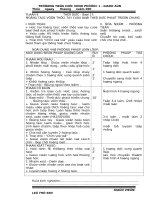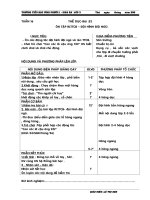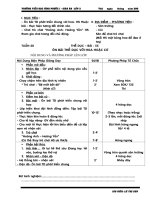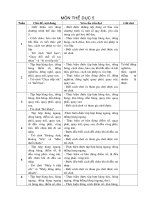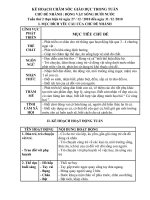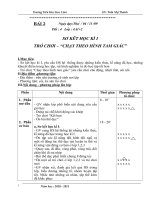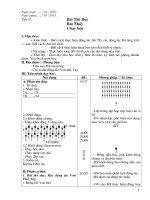Tài liệu Damascus Courts the West: Syrian Politics, 1989-1991 (Policy Papers, No. 26) doc
Bạn đang xem bản rút gọn của tài liệu. Xem và tải ngay bản đầy đủ của tài liệu tại đây (1.39 MB, 104 trang )
POLICY PAPERS
NUMBER 26
DAMASCUS COURTS THE WEST:
SYRIAN POLITICS, 1989-1991
DANIEL PIPES
THE WASHINGTON INSTITUTE FOR NEAR EAST POLICY
WASHINGTON, D.C.
Library of Congress Cataloging-in-Publication Data
Pipes,
Daniel
"Damascus Courts the West: Syrian Politics, 1989-1991" /
Daniel Pipes.
p.
cm. - (Policy papers / Washington Institute for Near East
Policy: no. 26)
Includes bibliographical references.
ISBN 0-944029-13-2: $11.95
1.
Syria—Foreign Relations. 2. Syria—Foreign Relations—
United States. 3. United States—Foreign Relations—Syria. I. Title.
II.
Series: Policy papers (Washington Institute for Near East Policy): no. 26.
DS95.5.P57 1991
327.5691—dc20 91-30228
CIP
Copyright © 1991 by
The Washington Institute for Near East Policy
1828 L Street, N.W., Suite 1050, Washington, D.C. 20036
Library of Congress Catalog Card Number: 91-30228
ISBN 0-944029-13-2
Cover design by Jill Indyk
THE AUTHOR
Daniel Pipes, director of the Foreign Policy Research
Institute in Philadelphia, wrote this study as the Blinken
Fellow at the Washington Institute for Near East Policy. Two of
Mr. Pipes's books were published early in 1990,
Greater
Syria:
The
History
of an Ambition (New York: Oxford University Press,
1990) and The Rushdie Affair: The
Novel,
the
Ayatollah,
and the
West
(New York: Birch Lane Press, 1990). He co-edited a study,
Friendly Tyrants: An American Dilemma, forthcoming from St.
Martin's Press.
The opinions expressed in this Policy Paper are those of the
authors and should not be construed as representing those of
The Washington Institute for Near East Policy, its Board of
Trustees or its Board of Advisors.
ACKNOWLEDGEMENTS vii
PREFACE ix
EXECUTIVE SUMMARY xi
INTRODUCTION: ASSAD, THE ODD MAN IN 1
I POLITICS IN SYRIA 3
H SOVIET RETREAT AND THE KUWAIT
CRISIS 13
in CONFLICT WITH ISRAEL 33
IV ASSAD'S FREEDOM OF MANEUVER 51
V U.S. POLICY 59
APPENDICES 69
Mr. Pipes thanks Christopher Strawbridge in Philadelphia
and Maria Massi in Washington for their help with research.
He is especially grateful to Adam Garfinkle and Ronald D.
McLaurin for their detailed comments. Mr. Pipes is also
obliged to the participants who critiqued this study at a
Washington Institute seminar in July 1991.
Funding for this paper was provided by the Blinken
Foundation of New York.
The past year has witnessed a series of extraordinary events
in the Middle East. One of the most significant, and perhaps
the most intriguing, has been Syrian leader Hafez al-Assad's
turn towards the West, and his eagerness to accommodate the
United States after years of leading the anti-West rejectionist
camp of Arab politics. This new direction in Syrian policy has
led to Syria siding with the U.S. led coalition against Iraq and
its willingness to engage in the peace process being fostered by
the United States. At the same time it has enabled Syria to
consolidate its presence in Lebanon without criticism from the
West and to generally be accepted as a more respectable
member of the family of nations.
Syria's political and strategic importance in the Middle
East, and its key role in the unfolding peace process, lend
special interest and salience to Daniel Pipes' study of the recent
shifts in Syrian policy. In this paper he places Assad's current
actions in the context of his career, his regime, and the
challenges he faces as a result of the loss of Soviet patronage in
the wake of Mikhail Gorbachev's steady disengagement from
regional clients and issues. This, more than anything, Daniel
Pipes argues, has stimulated Assad's new policy direction,
opening up new opportunities—yet generating new
uncertainties as well. Notwithstanding his present
cooperativeness, Assad is still a cunning, if often brilliant,
authoritarian leader, and Western policymakers would do
well to tread with caution in dealing with him. After
analyzing Assad's past successes and current predicaments,
Dr. Pipes offers a series of policy suggestions that should be of
great help to Western nations in assessing how they should
best avail themselves of this new moment in Syrian politics for
the good of the people of the Middle East—Syrian and non-
Syrian alike.
This study's depth, timeliness and literary grace should
make it a valuable addition to current policy debates, and a
crucial document for assisting American policymakers in
setting the U.S. compass for the next round of Mideast
diplomacy.
Barbi Weinberg
President
August 1991
EXECUTIVE SUMMARY
The Syrian regime of Hafez al-Assad has in the past year
seemed to change direction, first with tentative moves toward
liberalization, then by siding with the American-led coalition
that fought against Saddam Hussein and, perhaps most
dramatically, by acceding to America's wish that it attend a
peace conference with Israel. There is no doubt that U.S
Syrian relations have greatly improved in the process. The
meaning of that shift, however, is far from certain. How
should America respond to Assad's new course? Should he be
accepted as a partner in U.S. regional efforts, or perhaps the
U.S.
should take advantage of this moment to pressure him into
altering his regime? Is this a new face that Syria is presenting
to the West, and if
so,
does it call for caution or hope or perhaps
both?
Brutal totalitarian though Assad may be, he is a subtle and
highly sophisticated politician. Unlike Saddam Hussein, his
perennial rival for the mantle of Ba'athist leadership, Assad is
shrewd, nimble, patient, and measured (though by no means
squeamish) in his use of violence. Since assuming power in
1969 he has skillfully pursued his chief goals: consolidating
his minority-based 'Alawi regime, extending the reach of
Syria's regional influence and assuming the lead in the Arab
military confrontation with Israel. The latter goal, which has
taken the form of an attempt to attain strategic parity with the
Zionist foe, has remained elusive, not for strictly military
reasons, but because the police state that Assad has imposed on
Syria has not been able to match the social and economic
development of the Jewish State. The Syrian economy in
particular has been nearly run into the ground by two decades
of Assad's rule.
Throughout, Assad has depended on his superpower patron,
the Soviet Union. The disengagement from regional
entanglements initiated by Mikhail Gorbachev was an
unexpected and potentially threatening development for
Assad, auguring the loss of his patron and of a wide network of
military and political relationships throughout the Soviet bloc,
at a time when his economy could ill afford this. By mid-1990,
the writing was on the wall. It is this development more than
any other that accounts for Assad's courtship of the United
States.
Saddam Hussein's invasion of Kuwait provided Assad with
an unexpected solution to his problems and he played this
opportunity masterfully. By allying himself with the United
States, Assad was able to finally best his Ba'athist rival,
Saddam, secure his grip on Lebanon, win economic assistance
and enter the good graces of the United States. While the
Kuwait crisis strengthened Assad's hand vis-a-vis the PLO, Iraq
and Lebanon, it grew weaker in relation to Jordan, Turkey and
Israel.
Having moved Syria's government closer to the United
States, can Assad now end Syria's longstanding hostility
towards Israel? Assad's need to prove his
bona fides
to his non-
'Alawi countrymen have long made the chances of his
concluding peace with Israel remote. Since Egypt concluded a
separate peace with Israel in 1978, Syria has been the linchpin
of the state-to-state confrontation that, notwithstanding the
drama of the Palestinian uprising, is the heart of the Arab-
Israel conflict. Syria's people have long been unalterably
opposed to peace with Israel. Generally, Assad has overridden
the popular will when it comes to the crucial domestic issues at
the heart of his regime and done his best to heed it on the
comparatively less-crucial questions of foreign policy.
At the same time, there has long been a wide consensus
across the Israeli political spectrum against ceding the Golan
Heights, which Syria lost in its offensive against Israel in 1967.
Yet Assad could reach some sort of peace if the right
incentives—avoiding a major war or improving relations with
the West—were in place. The defeat of Iraq has tipped the
military balance against Syria on Israel's eastern front; at the
same time, Assad has given no sign of curtailing any of his
xii
current military capabilities. His current entry into the peace
process seems more a change of tactics than a change of heart,
more along the lines of Arafat's declaration of late 1988 than
Anwar Sadat's journey to Jerusalem.
Assad does respond to incentives and his behavior could be
changed by the United States if it undertakes its policies
towards Syria with sufficient care and circumspection. Major
changes in Syria are unlikely until Sunnis attain power,
something which cannot be expected, if at all, for some time to
come. Meanwhile, as the price of its friendship, continued co-
operation and support, America can demand that Assad take a
number of steps, some far-reaching and some symbolic,
bearing in mind Assad's extraordinary agility and the moral
unacceptability of the regime he represents. Specific moves
that America could undertake would include urging Assad to
improve his human rights record, make good on his financial
obligations to Western countries, and stop supporting terrorism
and drug-trafficking.
Most likely, Assad will try to induce Washington to pay
him for allowing himself to be helped. Rather than allow this
to happen, the United States can take advantage of Assad's
relative weakness at this time to effect positive change, through
policies that synthesize caution for today with hope for the
future.
xin
After thirty-five years of grim relations, Damascus and
Washington suddenly find themselves agreeing on a few
things. First, some 18,000 troops and 300 tanks from Syria stood
side-by-side for several months with their American
counterparts in the deserts of Arabia, facing down Saddam
Hussein. When war came, American and Syrian soldiers
stood together and called themselves allies.
Second, the Syrian media toned down their habitually
vicious anti-American rhetoric; no longer did the United States
stand accused of heinous imperialism. At the same time,
diplomatic contacts increased steadily, from the assistant
secretary of state for Middle East affairs visiting Damascus in
August 1990, to the secretary of state in September, to President
Bush meeting Hafez al-Assad in Geneva in November (the first
such summit in thirteen years).
Finally, President Hafez al-Assad agreed in July,
apparently without preconditions, to participate in an
American-sponsored peace conference. Terming President
Bush's initiative "an acceptable basis" for conducting peace
talks with Israel, the Syrian leader may have opened a new era
in Syrian foreign policy.
These changes, some of them quite abrupt, raise several
questions: Have the Syrians been riding out foul weather,
waiting for circumstances to improve? Or is a more
fundamental shift underway? With regard to Israel, has Assad
undergone a change of heart, or has he made tactical
adjustments in a moment of weakness? Should the U.S.
government respond by attempting to build on a new and still
2 DAMASCUS COURTS THE WEST
raw quasi-alliance, or should it again distance itself from a
brutal tyrant?
Some answers came soon after the war with Iraq ended and
Secretary of State James A. Baker III began his rounds of shuttle
diplomacy, casting Syria in a lead role. His efforts soon made
it clear that while the Syrians were unlikely to make rapid or
deep changes in their relations with Israel, they were willing
to countenance tactical shifts of genuine significance. But what
of matters lying beyond the Arab-Israel peace process—Syria's
internal circumstances, relations with other neighbors and the
outside world?
I attempt to answer these questions by presenting a tour
d 'horizon
of Syria in the tumultuous period between the Berlin
Wall's collapse in November 1989 and the summer of 1991.
We begin with an analysis of Assad's political character and a
survey of recent developments both inside Syria and outside it
(with special attention to the decline of Soviet power and the
Kuwait crisis). We then bring under close scrutiny what is
probably Syria's key bilateral relationship, the one with Israel.
After some thoughts on Assad's freedom of maneuver and an
assessment of his position today, we focus on U.S Syrian ties
and conclude with recommendations for American
policymakers.
A methodological note: Before 1970, there was a profusion
of information about Syria—insiders' rumors, documents, and
memoirs that reached print. Syrians had a deserved reputation
for gregariousness and the study of their country was
relatively simple. But Syria is now a land of near-silence, and
little except officially-sanctioned information gets out. Survey
research barely exists, or if it does, it is not made public.
Foreign press coverage is considerably more restricted than in
the USSR; and the domestic media have yet to discover
glasnost.
Freedom of expression is so limited that even novels and other
forms of fiction offer little insight into the mood of Syrians.
Therefore, just as with other closed countries,
generalizations about Syrian public opinion must be derived
from such inadequate sources as Syrian opposition groups and
emigres,
as well as foreigners in Syria, especially diplomats and
journalists.
D.P. Washington and
July
1991
Philadelphia
I POLITICS IN SYRIA
"Assad is Syria and Syria is Assad."
1
As in all one-man
dictatorships, politics in Syria is dominated by the ruler, his
goals,
and foibles. Hafez al-Assad unilaterally issues the
country's laws and makes most of the life-and-death decisions
affecting the twelve million Syrians he rules. To understand
Syrian politics, it is therefore crucial to begin with the
personality and aspirations of its ruler. One way to approach
Assad's character is by comparing him with Saddam Hussein.
ASSAD VS. SADDAM
The two men have much in common. They are about the
same age (Saddam was born in 1937, Assad in 1930) and come
from minority backgrounds. Both grew up in an impoverished
countryside with a twentieth century tradition of exporting
people to the cities. Both experienced Egyptian prisons and
have effectively ruled their countries since about the same
year (1972 for Saddam, 1969 for Assad). Both imposed an
extreme centralization, to create a stable order where turmoil
had previously prevailed. Both are far more interested in
building their militaries than their countries. Each of them
looked to Moscow for primary support, but on occasion wooed
the U.S. government. Both rely extensively on the terrorist
^Amos Gilboa, a former Israeli intelligence officer, quoted in Alan
Cowell, "Trouble in Damascus," The New York Times
Magazine,
April 1,
1990.
4 DAMASCUS COURTS THE WEST
instrument. They have claimed to represent the Palestinians
and sought to control weak neighbors.
In personality, they share vaulting ambitions, a passion for
secrecy, and a Manichean outlook that divides the world into
agents and enemies. Both tend toward brinkmanship and a
readiness to sacrifice the interests of their countries for
personal and ethnic interests. Their political systems rely to a
strikingly parallel degree on Ba'ath Party control, the pervasive
use of informants, and brutality. (Middle East Watch found
torture in Iraq to be "used routinely"; Amnesty International
has termed the Syrian jails "almost a research center for
torture.") Though life in Syria is an iota better,^ the two
dictatorships in the Fertile Crescent are about as similar as any
pair of governments on the planet.
The two men also differ profoundly. Where Saddam revels
in brutality for its own sake, Assad resorts to it as an instrument
of power. The one kills with his own hands, the other keeps
his distance from such unpleasantries. Saddam's ambitions
know no limit: he seeks to become both the greatest leader in
Iraqi history and a giant on the world stage; his dreams of
glory distort practical decisionmaking. In contrast, Assad
knows his limitations and acts within their parameters: the
conquest of Lebanon and the perpetuation of 'Alawi rule are
quite enough for him for now, thank you. Saddam's overt
aggression makes him enemies everywhere; Assad's is
cloaked in an ambiguity which allows hostile states the luxury
of ignoring his trespasses. Both leaders follow policies which
the outside world often finds difficult to understand, but while
Saddam confuses observers through stupidity, Assad does so
through subtlety.
While Saddam and Assad both engage in international
brinkmanship, only Assad can reliably locate the brink.
Saddam displays an increasingly uncontrollable streak of
impatience
3
and has a terrible sense of timing (the invasion of
*But not much more. Robert Fisk exaggerates terribly when he writes
that in comparison to Iraq, Syria is "indeed a 'liberal democracy." See
Pity
the
Nation:
Lebanon
at War (London: Oxford University Press, 1991), p.
178.
^Saddam Hussein did not get to where he is today by making the sort of
wrong-headed decisions that have so consistently been the case during
the past year. Indeed, two of his biographers, Efraim Karsh and Inari
POLITICS IN SYRIA 5
Kuwait could not have occurred at a worse moment from the
Iraqi point of view); Assad is infinitely deliberate and has a
most refined timing (the seizure of Beirut in October 1990,
fifteen years after Syrian military involvement in Lebanon
began, was a political masterpiece). More broadly, Saddam
Hussein showed in 1990-91 that he may be one of the worst
strategists and tacticians of history;
4
in contrast, Assad rightly
prides himself on his skills as a military planner. Like his
adopted namesake, the lion, Assad is a patient operator. He
probes his opponents' weaknesses, waits for the right moment,
chooses the most advantageous field of battle, and strikes. In
this way, Assad has defeated one enemy after another—the
Muslim Brethren, Lebanese militias, American troops in
Beirut, Israelis in south Lebanon, and Iraqi armed forces.
Observers are in agreement as to his impressive skills. Thus,
Annie Laurent and Antoine Basbous see his main
characteristics as "patience and a taste for secrecy."
5
Dov
Tamari concludes that "the Syrian regime has demonstrated
patience and restraint on the one hand, persistence and
stubborness on the other."
6
Imagine—to take this comparison one step further—that
Assad ruled in Baghdad, and that he wanted to bring Kuwait,
with all its wealth and coastline, under his control. What
would he have done differently from Saddam? Everything.
Rautsi, repeatedly stress his being a "fundamentally cautious man."
Saddam Hussein: A Political Biography, (London: Brassey's [UK], 1991), p.
85.
remarks of Mustafa Tallas, Syria's defense minister, are to the
point: "Saddam Hussein could not defeat Iran, so how is he going to
defeat twenty-eight states headed by the United States? This is a very
simple matter of arithmetic that he should have considered, but he
thinks like an Australian mule. He thought that by putting a marshal's
insignia on his shoulder he would be able to defeat the United States in
battle"
(Akhbar
al-Yawm,
January 26, 1991).
5 Annie Laurent and Antoine Basbous,
Guerres secretes
au Liban (Paris:
Gallimard, 1987), p. 78.
"Dov Tamari, "The Syrian-Israeli Balance of Forces and Strategic
Parity," The Middle East Military Balance, 1989-90, edited by Joseph Alpher
(Boulder, Colo.: Westview, 1990), p. 95.
6 DAMASCUS COURTS THE WEST
He would have prepared the way years ahead of time by
hosting Kuwaiti dissident movements in Baghdad and laying
repeated but eliptical claims to Kuwait. When the time was
right, he would have solicited an invitation from bona fide
Kuwaiti leaders to send Iraqi troops into Kuwait. Rather than
seize the whole country, he would have taken only some slices
of it (the Rumayla oil field, Bubiyan and Warba Islands) and
worked to get his allies and agents into power. The outside
world would surely have protested, but Assad's salami tactics
would have allowed him to take Kuwait without sustained
armed opposition. In the end, just as everyone acquiesced to his
seizure of Lebanon, so they would have gone along with his
control over Kuwait.
In short, Assad is the virtuoso politician of the Middle East.
ASSAD'S GOALS
Understanding Assad's motives is no easy task, for he is a
subtle and highly sophisticated politician whose words only
vaguely point to what he thinks, and whose actions only
suggest what he actually intends.
7
Even the most basic matters
are in question. Does Assad pragmatically exploit anti-Zionism
as a means to an end or does he feel, as some argue, an
"intense hatred of Israel"?
8
Part of the mystery results from his readiness to shift
policies, quickly, dramatically, and with a nimbleness that
never ceases to impress Middle East analysts. On occasion this
has lead to stunning reversals of course. He dropped the
Palestinian-Muslim-Leftist coalition in the Lebanese civil war
in June 1976 in favor of the Maronite-Rightist side. He
condemned the Egyptian government for its March 1979 peace
'Two biographies of Assad have recently appeared in English: Moshe
Ma'oz,
Asad,
The Sphinx of Damascus: A Political Biography (New York:
Weidenfeld & Nicholson, 1988) and Patrick Seale, Asad of
Syria:
The
Struggle
for the
Middle
East (Berkeley: University of California Press, 1989).
While Seale's book contains much new information about Asad and
Syria, its apologetic quality renders it less than trustworthy.
"Margaret G. Hermann, "Syria's Hafez al-Assad," in Leadership and
Negotiation
in the Middle
East,
edited by Barbara Kellerman and Jeffrey Z.
Rubin (New York: Praeger, 1988), p. 73.
POLITICS IN SYRIA 7
treaty with Israel, repeated that condemnation regularly for a
decade, then suddenly made up with Cairo in December 1989.
Still, it is possible to point to several constant goals. Three stand
out. Going from greater to lesser, they are: continued rule by
Assad and the 'Alawis; the achievement of Greater Syria; and
the desire for strategic parity with Israel.
The single most important goal of the Assad regime is to
retain Syria in the hands of Hafez al-Assad, his kinsmen, and
the 'Alawi people. 'Alawis, who constitute about 12 percent of
Syria's population, are a mystery to most of their countrymen.
Though sometimes portrayed as a sect of Islam, 'Alawism is in
fact a wholly distinct religion. It rejects the sacred law of Islam
(the Shari'a), it maintains an elaborate but secret theology, and
its rites are alien to Islam. As the impoverished residents of an
isolated region, 'Alawis have a long history of being feared
and despised by mainstream Muslims. Accordingly, the
notion of an 'Alawi ruler in Damascus is repugnant to most
Syrian citizens; and this animosity has shadowed Assad and
the 'Alawis since completing their ascent to power in February
1966.
In turn, Muslim hostility has compelled the regime to
recruit heavily among its own community, thereby causing it
to take on a distinctly sectarian cast. The years have intensified
these resentments, to the point that Assad's overthrow would
almost certainly lead to communal violence against 'Alawis.
To protect themselves, then, the 'Alawis must stay in power.
9
The result is a vicious cycle of hostility and repression.
Still, the government makes efforts to reach out to the
majority Sunni Muslim population. Like many other
unpopular regimes, it does so by avoiding the contentions of
the domestic arena and stressing issues of foreign policy
instead. Foremost among these, at least since 1974, has been
the dream of a Greater Syria—a notional territory including
the territories of present-day Syria, Lebanon, Israel, the
occupied territories, Jordan, and a portion of Turkey. Greater
Syria is a new term for what until the fall of the Ottoman
Empire was just called "Syria." It is the Levant, a discrete
cultural and ecological area east of the Mediterranean Sea.
Greater Syria is hardly Assad's invention; quite the contrary,
9
They have also developed a militia, headed by Hafez al-Assad's brother
Jamil, made up only of 'Alawis. Should the regime fall, this militia
will probably protect the 'Alawis' home region of Latakia.
8 DAMASCUS COURTS THE WEST
many others—including An tun Sa'ada and King * Abdullah of
Jordan—have sought since 1920 to piece the units together. But
Assad, who has made this goal a centerpiece of his foreign
policy since about 1974, has had more success at it than any of
his predecessors.
Israel is the most prominent of Greater Syria's several
regions, and for several reasons. Anti-Zionism permits Assad
to atone for the 'Alawi community's (and indeed, Assad's own
grandfather's) past friendliness to Zionism.
10
It allows Assad to
tap the Sunni Muslims' hostility toward the Jewish state,
binding his regime to the disenfranchised majority. (My
instinct—and it's not much more—tells me that after
Palestinians, Syrians are the Arabic-speakers most reluctant to
accept Israel's existence.) The effort to destroy Israel appeals to
the Sunnis, giving these disenfranchised elements something
in common with the regime. Assad's ambitions toward
Palestine take both direct form (he claims Palestine as
Southern Syria) and indirect (he stands up for Palestinian
rights and tries effectively to control Palestinian
organizations).
11
Behind his flexibility of form lies a consistent
claim; the future of the region west of the Jordan River should
be subject to Damascus.
Since 1978, this goal has taken the form of a doctrine of
strategic parity, or the ability to confront Israel from a position
of strength. Assad defines parity in the broadest terms: "It does
not mean that we should have a tank for each Israeli tank . . .
Strategic parity is composed of many elements. Before parity
in weapons, it is parity in the cultural, economic, and political
10
For example, a June 1936 letter to the French prime minister signed
by six 'Alawi notables, possibly including Assad's grandfather, expressed
solidarity with the Zionists in Palestine: "Those good Jews brought
civilization and peace to the Arab Muslims, and they dispersed gold and
prosperity over Palestine without damage to anyone or taking anything
by force." Abu Musa al-Hariri, Al-'Alawiyun— an-Nusayriyun (Beirut: n.p.,
1400/1980), pp.
228-31.
^Proof that Assad's interest in the Palestinians has nothing to do with
humanitarian impulses and everything to do with his ambition to
control an Arab regime in Jerusalem lies in the execrable treatment of
Palestinians living in Syria. For details, see Middle East Watch, Human
Rights in
Syria
(New York: Human Rights Watch, 1990), pp. 94-99.
POLITICS IN SYRIA 9
fields.
"^ In theory, parity is as much offensive as defensive;
in fact, it appears to be a holding posture until Syria's alliances
(with Arab and Muslim states, the Soviet bloc) come out of the
doldrums and its allies take a more active role versus Israel.
PARTY RULE
Ironically, while Assad has more than achieved a strict
military balance (see Appendix I), strategic parity has
completely eluded him, precisely because the cultural,
economic, and political development of Syria has languished
under his rule. Assad has imposed a Soviet-style police state on
the Syrian population, with all the poverty and repression such
a system entails. The Ba'ath party openly runs the government
apparatus, which in turn runs the country for the benefit of a
small nomenklatura. So heavily is the press censored that one
Syrian writer defined its fundamental task being "to prevent
information from reaching the people rather than provide it."
13
As a report from mid-1990 made clear, secrecy abounds:
The official inflation rate has not been announced for a
year, supposedly because of "computer problems." The last
five-year economic plan, due out in 1986, has never been
published. There are no telephone books published in
Syria—if you don't know the number already, don't try to
call. The national budget is published but it's calculated
with four totally different exchange rates so no one can
make heads or tails of it. When Syrian clocks spring
forward and fall back with the seasons, the official
change is announced only the day before. 14
Damascus, May 7, 1990. References to radio and television
broadcasts derive from the Foreign Broadcast Information Service, Daily
Report, as do some news agency and newspaper reports. I have amended
FBIS translations for purposes of style.
Sadiq (pseud.), "The Road to Damascus is Plagued with Censors,"
Index on
Censorship,
February 1990, p. 20.
Morello, "Only Mystery Lives in Syria's Presidential Palace,"
The Philadelphia Inquirer, May 8, 1990.
